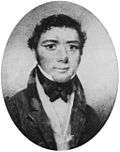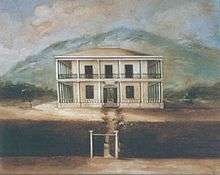Mary Dominis
Mary Lambert Jones Dominis (August 3, 1803 – April 25, 1889) was the first mistress of Washington Place in Honolulu. She was also the mother of John Owen Dominis, Prince Consort of the Kingdom of Hawaii, and mother-in-law of Hawaii's final monarch Queen Liliʻuokalani. She is credited with starting the Christmas tree and Santa Claus traditions for Christmas in Hawaii
Early life

She was born Mary Lambert Jones, on August 3, 1803, in Boston, Massachusetts, to Owen Jones and Elzabeth Lambert. Her family were connected with the first English settlers of New England.[1][2]
She married the merchant sea Captain John Dominis, originally of Trieste, on October 9, 1821. They had three known children: Mary Elizabeth Dominis (1825–1838), Frances Ann Dominis (1829–1842), and John Owen Dominis (1832–1891). The family lived in Boston and were listed in directories of Boston until about 1831 when they moved to Schenectady, New York where John Owen was born. Captain Dominis was alway from home for prolonged amount of times and traded in the Far East and the Oregon and California coasts. Captain Dominis, Mary and their son John Owen Dominis re-settled in Honolulu, in the Kingdom of Hawaii, arriving by the bark Jones on On April 23, 1837. Their two daughters were left in New England for their education. Mary Elizabeth and Frances Ann both died in 1838 and 1842, respectively, and were buried in the Vale Cemetery of Schenectady.[2][3][4]
Life in Hawaii

In Honolulu, the Dominises started building a mansion, on lands awarded by King Kamehameha III]. Between 1841 to 1847, the construction details were largely attended by Mary since Captain Dominis was mostly away on voyages raising money for the building cost. In 1846 Captain Dominis sailed for China on the brig William Neilson, intending to purchase Chinese-made furniture for the house which was nearing completion. The ship was lost at sea, along with the American commissioner George Brown, and Mary became a widow.[3][4] After the reality of her husband's death became apparent, she opened up Washington Place to boarders to support herself and her young son John Owen Dominis. Among these tenants was Anthony Ten Eyck, the American resident commissioner to Hawaii, from 1846 to 1849. While boarding with the Dominises, his room became the United States legation in Honolulu and he named the mansion "Washington Place" after the first American president George Washington. The name was officially approved by King Kamehameha III.[5] [6] Other tenants and guests included American diplomats Luther Severance, David L. Gregg and Elisha Hunt Allen and politicians William Little Lee and Robert Crichton Wyllie.[7]
On September 16, 1862, her son married the Hawaiian high chiefess Lydia Kamakaʻeha Pākī, the future Queen Liliʻuokalani. The "small and quiet" wedding was held at Haleʻākala, the residence of Bernice Pauahi Bishop and her husband Charles Reed Bishop. The ceremony was officiated by Rev. Samuel C. Damon in the Anglican rites. King Kamehameha IV and other members of the royal family were honored guests, but Mary Dominis made her disapproval apparent by not attending the ceremony. The couple moved into Washington Place. Through his new wife and connections with the king, Dominis would later become Governor of Oʻahu and Maui.[8]
Despite Liliʻuokalani's royal status, Mary Dominis disapproved of the marriage. According to historian James L. Haley, Mary Dominis was an "arrant racist" toward her daughter-in-law.[9] The married life of Dominis and Liliʻuokalani was a troubled one, however by the time of Mary's death, she had learned to accepted her. In Hawaii's Story by Hawaii's Queen, Liliʻuokalani revealed a little about her domestic difficulties:
As she felt that no one should step between her and her child, naturally I, as her son's wife, was considered an intruder; and I was forced to realize this from the beginning. My husband was extremely kind and considerate to me, yet he would not swerve to the one side or to the other in any matter where there was danger of hurting his mother's feelings. I respected the closeness of the tie between mother and son, and conformed my own ideas, so far as I could, to encourage and assist my husband in his devotion to his mother. Later in life Mrs. Dominis seemed to fully realize that there had been some self-sacrifice, and she became more and more a tender and affectionate mother to me as her days were drawing to a close.[10]
Mary Dominis died on April 25, 1889, and was buried at the Oahu Cemetery in Honolulu.[2][11] The American flag flew at Washington Place during her lifetime. After her death Liliuokalani took the flag down. It wouldn't be raised again until April 1917 when Liliuokalani raised it in honor of Hawaiian casualties in the sinking of the SS Aztec by German U-boats.[12]
Christmas in Hawaii
Mary Dominis is credited with starting the Christmas tree and Santa Claus traditions in Hawaii.[13][14] Christmas in Hawaii had been introduced by the American Protestant missionaries who arrived in the islands in 1820. However, celebrations were never consistent until the 1850s since the Puritanic origin of the New England missionaries disapproved of the non-canonical holiday. During the reign of King Kamehameha IV and his consort Queen Emma of Hawaii, the Christmas tradition received greater support under the influence of the newly established Anglican Church of Hawaii. On Christmas Eve of 1858, she invited the children of Honolulu and their parents to Washington Place to celebrate. The party, featuring the first appearance of a Christmas tree and Santa Claus in Hawaii, received significant coverage in the local Hawaiian newspapers: The Pacific Commercial Advertiser and The Polynesian.[13][14][15][16] The Advertiser reported:
Christmas passed off in good old fashioned style. The eve was ushered in by the assemblage of a large number of children and their parents at Washington Place, the mansion of Mrs. Dominis, where Santa Claus had given out that he would hold his court...A magnificent Christmas Tree had been provided...and the little folks as they gathered about it...found it all lighted up with candles, and the branches bending with the weight of gifts. Prompt as old Father Time ever was, bells were heard at the windows...and in a moment old Santa Claus stood at the door before the youthful group, who greeted him with a volley of merry shouts. He was dressed in the garb in which children love to imagine the saintly old elf...For an hour he bestowed his gifts with princely lavishness among the 100 children present, creating one of the happiest groups ever witnessed in Honolulu...who will long continue to talk of Santa Claus of Washington Place.[13][16]
References
- ↑ Kovacevic 1976, pp. 23–24.
- 1 2 3 "Death of Mrs. Dominis". The Pacific Commercial Advertiser. Honolulu. April 26, 1889. p. 2.; "Death of Mrs. Dominis". The Hawaiian Gazette. Honolulu. April 30, 1889. p. 3. "Mrs. Dominis Sr". The Daily Bulletin. Honolulu. April 25, 1889. p. 3.; "Laid to Rest". The Pacific Commercial Advertiser. Honolulu. April 29, 1889. p. 2.; "Laid to Rest". The Hawaiian Gazette. Honolulu. April 30, 1889. p. 4.; "Funeral of Mrs. Dominis Sr". The Daily Bulletin. Honolulu. April 29, 1889. p. 2.
- 1 2 Kovacevic 1976, pp. 3–24.
- 1 2 Price 2009, pp. 48, 50-51, 63.
- ↑ Price 2009, pp. 52, 55–56, 62.
- ↑ Proto 2009, p. 27
- ↑ Haley 2014, p. 183; Price 2009, p. 67
- ↑ Allen 1982, pp. 84–89; 98–99, 103–104; "Notes of the Week". The Pacific Commercial Advertiser. VII (12). Honolulu. September 18, 1862. p. 2. Retrieved September 26, 2016.; "Marela". Ka Nupepa Kuokoa. I (43). Honolulu. September 20, 1862. p. 3. Retrieved September 26, 2016.; "Na Mea Mare". Ka Hoku o ka Pakipika. II (52). Honolulu. September 18, 1862. p. 2. Retrieved September 26, 2016.
- ↑ Haley 2014, p. 200
- ↑ Liliuokalani 1898, pp. 23–24.
- ↑ Siler 2012, pp. 157, 161.
- ↑ Allen 1982, p. 392; Proto 2009, p. 207
- 1 2 3 Thrum, Thomas G., ed. (1921). "'Santa Claus' Advent in Honolulu". Hawaiian Almanac and Annual for 1922. Honolulu: Honolulu Star-Bulletin. pp. 58–61.
- 1 2 Dutton 1950, p. 7.
- ↑ Kanahele 1999, pp. 157–159.
- 1 2 "Notes of the Week". The Pacific Commercial Advertiser. III (27). Honolulu. December 30, 1858. p. 2.; "Christmas Party". The Polynesian. XV (35). Honolulu. January 1, 1859. p. 2.
Bibliography
- Allen, Helena G. (1982). The Betrayal of Liliuokalani: Last Queen of Hawaii, 1838–1917. Glendale, CA: A. H. Clark Company. ISBN 978-0-87062-144-4. OCLC 9576325.
- Dutton, Meiric Keeler (1950). Christmas in Hawaii. Honolulu: E. & M. Dutton. OCLC 16339340.
- Haley, James L. (2014). Captive Paradise: A History of Hawaii. New York: St. Martin's Press. ISBN 978-0-312-60065-5. OCLC 865158092.
- Kanahele, George S. (1999). Emma: Hawaii's Remarkable Queen. Honolulu: University of Hawaii Press. ISBN 978-0-8248-2240-8. OCLC 40890919.
- Kovacevic, Ante (1976). "On the Descent of John Owen Dominis, Prince Consort of Queen Liliuokalani". The Hawaiian Journal of History. Honolulu: Hawaiian Historical Society. 10: 3–24. hdl:10524/409. OCLC 60626541.
- Liliuokalani (1898). Hawaii's Story by Hawaii's Queen, Liliuokalani. Boston: Lee and Shepard. ISBN 978-0-548-22265-2. OCLC 2387226.
- Price, Virginia (March 2009). "Washington Place: Harboring American Claims, Housing Hawaiian Culture". Buildings & Landscapes: Journal of the Vernacular Architecture Forum. Minneapolis, MN: University of Minnesota Press. 16 (2): 48–72. OCLC 688617531.
- Proto, Neil Thomas (2009). The Rights of My People: Liliuokalani's Enduring Battle with the United States, 1893–1917. New York: Algora Publishing. ISBN 978-0-87586-720-5. OCLC 319248358.
- Siler, Julia Flynn (2012). Lost Kingdom: Hawaii's Last Queen, the Sugar Kings and America's First Imperial Adventure. New York: Atlantic Monthly Press. ISBN 978-0-8021-9488-6. OCLC 881683650.